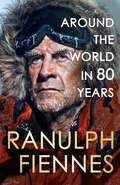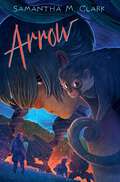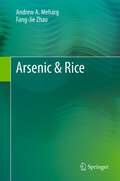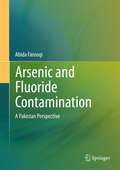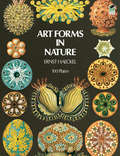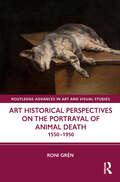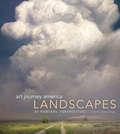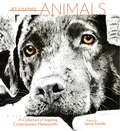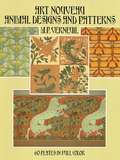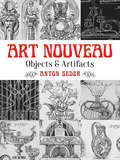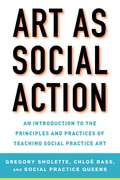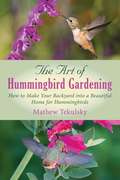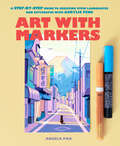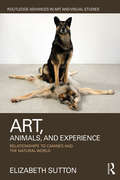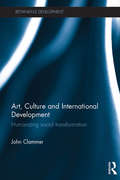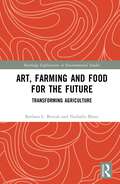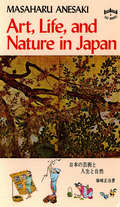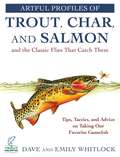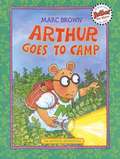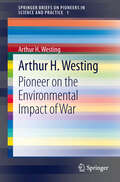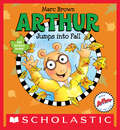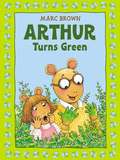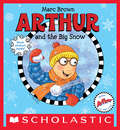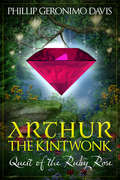- Table View
- List View
Around the World in 80 Years: A Life of Exploration
by Ranulph FiennesA CELEBRATION OF THE EXTRAORDINARY LIFE AND ADVENTURES OF 'THE WORLD'S GREATEST LIVING EXPLORER' --------On the eve of his 80th birthday, Sir Ranulph Fiennes looks back at his remarkable life and adventures.He's climbed Everest not long after a heart bypass operation, he's run seven marathons on seven continents, he's hauled loaded sledges across both polar ice caps and he's circumnavigated the earth...Ran Fiennes truly is the world's greatest explorer, and this book celebrates his 80th birthday by showcasing his greatest achievements in his own words. Featuring interviews and tributes from his friends, colleagues and admirers, Around the World in 80 Years celebrates the incredible life of a legendary explorer.
Arrow
by Samantha M. ClarkFrom the author of The Boy, the Boat, and the Beast comes a lush and timely tale about a boy who&’s grown up as the only human in an enchanted rainforest and what happens when people from the outside world discover his home.For the first twelve years of Arrow&’s life, he has grown up as the only human in a lush, magical rainforest that&’s closed off from the rest of the world. He was raised by the Guardian Tree, the protector of the forest, which uses the earth&’s magic to keep it hidden from those who have sought to exploit and kill it. But now the magic veil is deteriorating, the forest is dying, and Arrow may be the only one who can save it. Arrow has never seen another human until one day, a man in a small airplane crash-lands in the forest. Then, a group of children finds their way in, escaping from their brutal, arid world where the rich live in luxurious, walled-off cities and the poor struggle for survival. The Guardian Tree urges Arrow to convince the trespassers to leave by any means necessary. Arrow is curious about these newcomers, but their arrival sets off a chain of events that leave him with a devastating choice: be accepted by his own kind or fight to save the forest that is his home.
Arsenic & Rice
by Andrew A. Meharg Fang-Jie ZhaoRice is the staple food for half of the world's population. Consumption of rice is the major exposure route globally to the class one, non-threshold carcinogen inorganic arsenic. This book explains the sources of arsenic to paddy soils and the biogeochemical processes and plant physiological attributes of paddy soil-rice ecosystems that lead to high concentrations of arsenic in rice grain. It presents the global pattern of arsenic concentration and speciation in rice, discusses human exposures to inorganic arsenic from rice and the resulting health risks. It also highlights particular populations that have the highest rice consumptions, which include Southern and South East Asians, weaning babies, gluten intolerance sufferers and those consuming rice milk. The book also presents the information of arsenic concentration and speciation in other major crops and outlines approaches for lowering arsenic in rice grain and in the human diet through agronomic management.
Arsenic and Fluoride Contamination: A Pakistan Perspective (SpringerBriefs in Environmental Science)
by Abida FarooqiThis book presents an up-to-the-minute overview of arsenic and fluoride pollution of soil and groundwater in Pakistan. It includes the author's doctoral dissertation on Lahore as a case study and describes the mechanism of pollution on the basis of the findings in that area. The book highlights the concrete situation in Pakistan - including the severity of the problem, its health effects and the risks posed to the people living in affected areas by these two major pollutants- and points out essential research areas that call for immediate attention. As such, it draws attention to the need for management strategies in the affected areas and offers a valuable reference work on Pakistan for students and researchers alike.
Art Forms in Nature
by Ernst HaeckelErnst Heinrich Haeckel (1834-1919) was renowned as one of the foremost early exponents of Darwinism. His work was credited with having caused the acceptance of Darwinism in Europe, and his popular studies - preaching the continuity of all life, organic and inorganic, from prehistoric time to the present - converted tens of thousands of readers all over the world. Today, although no one is greatly interested in Haeckel the biologist-philosopher, his work is increasingly prized for something he himself would probably have considered secondary. These are the remarkable plates with which his work was illustrated, particularly his famous Kunstformen. The Kunstformen contains 100 beautiful lithographic plates which show a multitude of unusual life forms: Radiolaria, Foraminifera, and other forms of microscopic life; jellyfishes, starfishes, calcareous sponges, star corals, barnacles, and other sea life; mosses, lichens, red algae, ferns, fungi, orchids, and other plants; and turtles, moths, spiders, bats, frogs, lizards, hummingbirds, and antelope. With many drawings on each plate, each carefully drawn from nature, the subtle details of nature's art forms are easily compared and appreciated. In addition to being marvelous renderings, these plates have long been noted for the peculiar emotional appeal that they have for most viewers, a premonition of surrealism with exotic organic life forms stretching back to their roots in the inorganic, and individual details drawn with awareness of subtle evolutionary changes and millennia-long developments. Artists, illustrators, and others will find them still powerful as one of the landmarks of applied art.
Art Historical Perspectives on the Portrayal of Animal Death: 1550–1950 (Routledge Advances in Art and Visual Studies)
by Roni GrénThis study concentrates on the discourses around animal death in arts and the ways they changed over time.Chapter topics span from religious symbolism to natural history cabinets, from hunting laws to animal rights, from economic history to formalist views on art. In other words, the book asks why artists have represented animal death in visual culture, maintaining that the practice has, through the whole era, been a crucial part of the understanding of our relation to the world and our identity as humans. This is the first truly integrative book-length examination of the depiction of dead animals in Western art.The book will be of interest to scholars working in art history, animal studies, and cultural history.
Art Journey America Landscapes: 89 Painters' Perspectives (Art Journey)
by Kathy KippShowcasing the work of more than 100 top contemporary American master artists of our day, this book features landscapes (a popular subject for art collectors and a tradition throughout American art history) from all across the country-east and west, north and south-rendered in watercolor, oil, acrylic, pastel, colored pencil and mixed media. Accompanying each painting are the thoughts, techniques and inspirations for the paintings by each artist.
Art Journey Animals: A Collection of Inspiring Contemporary Masterworks (Art Journey)
by Jamie MarkleA Collection of Inspiring Contemporary Masterworks
Art Nouveau Animal Designs and Patterns: 60 Plates in Full Color (Dover Pictorial Archive)
by M. P. VerneuilThis design collection includes all 60 full-color plates from L'animal dans la décoration, a rare turn-of-the-century portfolio by M. P. Verneuil. Meticulously reproduced from the originals, these plates offer a splendid demonstration of the application of animal forms to decorative art. Included are not only representations of such traditional decorative motifs as deer, swans, and peacocks, but also depictions of creatures seldom associated with beauty and ornamentation: bats, mice, lizards, insets, and other less conventional subjects. M. P. Verneuil was one of the leading lights of the influential Art Nouveau movement. His extraordinary inventiveness and draftsmanship can be seen here in detailed tableaux of animals and plants often wittily represented as interlocking parts of a larger decorative design. Butterflies, dragonflies, and bats float amid schematized flora; sea horses, flying fish, and gulls cavort in and above stylized seas; and a host of other fauna is similarly rendered with breathtaking imagination and ingenuity. Graphic artists, illustrators, craftspeople -- any student of design -- will want to have this book as an invaluable copyright-free source of artistic inspiration and as an eye-opening excursion into the rich and sensuous realms of the finest Art Nouveau design.
Art Nouveau: Objects and Artifacts (Dover Pictorial Archive)
by Anton SederA revolutionary reaction to the eclectic historical styles of nineteenth-century art, the turn-of-the-century Art Nouveau movement drew much of its inspiration from nature. Applying its sinuous, curvilinear motifs to the decorative arts, graphics, architecture, sculpture, and painting, artists and crafters attempted to create a style suitable for a "modern" age. This treasury of rare Art Nouveau decorative ornaments offers an unusual selection of the genre's most strikingly imaginative graphics. Originally published in Paris in 1899 and sold by subscription, the collection features fifty full-page plates depicting a rich profusion of everyday items rendered in the distinctive Art Nouveau style. Intricate patterns of flowers, vines, faces, and other designs decorate scores of objects made of metal, ceramic, and glass: pitchers and vases, cutlery, walking sticks, jewelry, and other objects and artifacts. A source of authentic Art Nouveau graphics, this compilation will serve as an inspiration for artists, illustrators, and designers.
Art as Social Action: An Introduction to the Principles and Practices of Teaching Social Practice Art
by Gregory Sholette Chloë Bass Social Practice Queens"Art as Social Action . . . is an essential guide to deepening social art practices and teaching them to students." —Laura Raicovich, president and executive director, Queens MuseumArt as Social Action is both a general introduction to and an illustrated, practical textbook for the field of social practice, an art medium that has been gaining popularity in the public sphere. With content arranged thematically around such topics as direct action, alternative organizing, urban imaginaries, anti-bias work, and collective learning, among others, Art as Social Action is a comprehensive manual for teachers about how to teach art as social practice. Along with a series of introductions by leading social practice artists in the field, valuable lesson plans offer examples of pedagogical projects for instructors at both college and high school levels with contributions written by prominent social practice artists, teachers, and thinkers, including: Mary Jane Jacob Maureen Connor Brian Rosa Pablo Helguera Jen de los Reyes Jeanne van Heeswick Jaishri Abichandani Loraine Leeson Ala Plastica Daniel Tucker Fiona Whelan Bo Zheng Dipti Desai Noah Fischer Lesson plans also reflect the ongoing pedagogical and art action work of Social Practice Queens (SPQ), a unique partnership between Queens College CUNY and the Queens Museum.
Art of Hummingbird Gardening: How to Make Your Backyard into a Beautiful Home for Hummingbirds
by Mathew TekulskyThis book is devoted solely to hummingbird gardening and is a practical guide to cultivating flowers and other plants that will attract the hummingbirds of North America to your home and garden. You will be able to grow flowers in profusion and provide nectar for these smallest of birds, which hover on fast-beating wings while they drink from flowers including pink Chinese lantern, bladderpod, woolly blue curls, scarlet sage, penstemon, columbine, long strips of fuschia, and many others. The Hummingbird Garden is packed with pertinent information, from a description of what hummingbird gardening is all about to how hummingbirds can be conserved and protected. Tekulsky explains the extraordinary way hummingbirds live and behave, the regions they inhabit throughout the year, and their migrating habits. He discusses how to start your own garden by recommending what to plant and then outlines what interesting events will take place in it. The valuable appendixes give complete information on hummingbird and plant varieties, bird and conservation organizations, and mail-order sources, as well as an extensive bibliography. Beautiful color photos throughout show many different types of hummingbirds enjoying their wonderfully active lives in gardens created expressly for them.
Art with Markers: A Step-by-Step Guide to Creating Vivid Landscapes and Cityscapes with Acrylic Pens
by Angela PanA beautiful and accessible guide to making art with markers, from beloved artist Angela Pan.Versatile and approachable, marker pens are the must-have material for aspiring artists. Like watercolor, acrylic paint markers are beginner-friendly—you need just a bit of targeted instruction to achieve the styles you admire online. But where to begin?In Art with Markers, Angela Pan gives straightforward and thorough guidance on beginning your journey to becoming the artist you want to be. This handy art instruction book includes:22 illustrated, step-by-step projectsColor mixing, drawing, and blending techniquesTroubleshooting tips for preparing, cleaning, and storing markersWork through these pages and you’ll have your own collection of stunning landscape images and all the tools you need to turn your imagination into original marker art. Whether you’re curious to try a new medium or are already a fan of marker brands like Posca and Molotow, this book will be the perfect companion on your creative journey.EASY-TO-FOLLOW GUIDE: Step-by-step instructions make it possible for artists of all levels to enjoy and learn. This is an essential resource for art students and hobbyists wanting to add markers to their repertoire.POPULAR MARKER ARTIST: Angela Pan's dreamy landscapes and cityscapes, inspired by her travels, have won her many fans. She has created art kits and a series of sketchbooks for Mossery, been exhibited at Gallery Nucleus, and offers a drawing class on Domestika. WONDERFUL ART GIFT: Beautifully packaged, with full-color artwork throughout, this makes a great present alongside a set of markers. Perfect for the aspiring artist or art lover in your life!Perfect for:Aspiring creatives and art studentsExperienced artists branching out into the marker mediumFans of Angela Pan's art and tutorialsArt journalers and travel journalersFans of manga/anime and manga/anime-style illustrationGift-giving for birthday, graduation, bon voyage, or any special occasion
Art, Animals, and Experience: Relationships to Canines and the Natural World (Routledge Advances in Art and Visual Studies)
by Elizabeth SuttonElizabeth Sutton, using a phenomenological approach, investigates how animals in art invite viewers to contemplate human relationships to the natural world. Using Rembrandt van Rijn’s etching of The Presentation in the Temple (c. 1640), Joseph Beuys’s social sculpture I Like America and America Likes Me (1974), archaic rock paintings at Horseshoe Canyon, Canyonlands National Park, and examples from contemporary art, this book demonstrates how artists across time and cultures employed animals to draw attention to the sensory experience of the composition and reflect upon the shared sensory awareness of the world.
Art, Culture and International Development: Humanizing social transformation (Rethinking Development)
by John ClammerCulture is not simply an explanation of last resort, but is itself a rich, multifaceted and contested concept and set of practices that needs to be expanded, appreciated and applied in fresh ways if it is to be both valued in itself and to be of use in practical development. This innovative book places culture, specifically in the form of the arts, back at the centre of debates in development studies by introducing new ways of conceptualizing art in relation to development. The book shows how the arts and development are related in very practical ways – as means to achieve development goals through visual, dramatic, filmic and craft-inspired ways. It advocates not so much culture and development, but rather for the development of culture. Without a cultural content to economic and social transformation the problems found in much development – up-rooting of cultures, loss of art forms, languages and modes of expression and performance – may only accelerate. Paying attention to the development of the arts as the content of development helps to amend this culturally destructive process. Finally, the book argues for the value of the arts in attaining sustainable cultures, promoting poverty alleviation, encouraging self-empowerment, stimulating creativity and the social imagination, which in turn flow back into wider processes of social transformation. Discussion questions at the end of each chapter make this book ideal to help foster further thinking and debate. This book is an inspiring read for postgraduate students and researchers in the fields of development studies, cultural studies and sociology of development.
Art, Farming and Food for the Future: Transforming Agriculture (Routledge Explorations in Environmental Studies)
by Nathalie Blanc Barbara L. BenishThis book explores the impact of artistic experiments in inspiring people to turn away from current food consumerism and take an active role in preserving, sustaining, and protecting the environment. As artists are expanding their practice into social justice and community concerns, erasing traditional forms of expression and integrating others, the culture around food and its production has been added to a new vocabulary of experiential art. The authors measure the impact of such experiments on local food consumption and production, focusing on education and youth, both in the surrounding community and culture at large. They suggest how these projects can be up-scaled to further encourage sustainable solutions for our environment and communities. The book explores the reflections and motivations of case study practitioners in urban and rural areas and, through interviews, engages with artists who are pioneering a new trend to create hubs of activity away from traditional art spaces in cities to follow a non-hierarchal practice that is de-centralized and communally based. This book will be of great interest to academic readers concerned with issues related to environmental aesthetics, eco-design, eco-criticism, culture, heritage, memory, and identity, and those interested in the current debates on the place of aesthetics and culture in sustainability.
Art, Life, and Nature in Japan
by Masaharu Anesaki Terence BarrowThe artistic and philosophical heritage of Japan has a special meaning for the modern world. During the present century, Japanese thought and Japanese art have exerted a strong influence on the western mind. Art, Life, and Nature in Japan takes us to the roots of Japanese culture and the origins of this influence.In this brief but deeply meaningful book Masaharu Anesaki provides a panoramic view of Japanese culture, with particular emphasis on the spirit of Japanese art. The book has, in fact, established itself as a classic, and it ranks with such other valuable works of its time as The Book of Tea, in which Kakuzo Okakura deals with a similar theme.Anesaki expresses himself in crystal-clear English to convey a message that is significant today as it was before World War II, when his book first appeared. He advocates peace and a turning inward to the beauty of art and nature. He is as familiar with the Zen philosophy of the samurai and the tea master as with sentiments of ancient court noblemen and the quiet thought of a humble peasant.
Artful Profiles of Trout, Char, and Salmon and the Classic Flies That Catch Them: Tips, Tactics, and Advice on Taking Our Favorite Gamefish
by Dave Whitlock Emily WhitlockIt is with passion and clarity that Dave Whitlock describes trout, salmon, char, and how to fly fish for them. Artful Profiles of Trout, Char, and Salmon and the Flies That Catch Them is a collection of articles spanning Whitlock's career, all of which are essential reading for any fly-fisher. Over the past fifty years, he has amassed an incredible amount of knowledge and written a large number of articles, many of which appeared in Trout magazine and are featured within. Here, Whitlock deftly, accessibly, and thoroughly goes through a vast range of topics, including:Insights into the many subspecies of trout, char, and salmon Casting methods for every scenario Drawing out shy fish Types of flies for different waters and situations Accurately imitating food sources And much more! Discover a wealth of information consolidated by an experienced and devoted angler. Artful Profiles of Trout, Char, and Salmon and the Flies That Catch Them is absolutely packed with tried-and-true tips, tactics, and techniques that are presented concisely alongside colorful illustrations by Whitlock himself. This book is a must have for anyone with an interest in angling, whether they are an absolute beginner, or an experienced angler with years under their belts.
Arthur Goes to Camp
by Marc BrownPoor Arthur. He and the boys can't seem to do anything right at Camp Meadowcroak. Awful food, poison ivy, and losing to the girls in every sport are more than he can take. Arthur plots to run away just as the other campers plot to win the big scavenger hunt against their archrivals at Camp Horsewater. What happens when the two schemes collide makes a rousing finale to a funny, reassuring picture book. Arthur Goes to Camp brings more good laughs and learning to the growing number of Arthur fans.
Arthur H. Westing: Pioneer on the Environmental Impact of War (SpringerBriefs on Pioneers in Science and Practice #1)
by Arthur H. WestingSince the 1960s the environment has become an issue of increasing public concern in North America and elsewhere. Triggered by the Second Indochina War (Vietnam Conflict) of 1961-1975, and further encouraged by the International Conference on the Human Environment, held in Stockholm in 1972, the environmental impact of war emerged and grew as a topic of research in the natural and the social sciences. And in the late 1980s this led additionally to a focus and debate on environmental security. Arthur Westing, a forest ecologist, was a major pioneer contributing and framing both of those debates conceptually, theoretically, and empirically, starting with Harvest of Death: Chemical Warfare in Vietnam and Cambodia (1972) (co-authored with wildlife biologist E.W. Pfeiffer and others). As a Senior Researcher at the Stockholm and Oslo International Peace Research Institutes (SIPRI and PRIO), and as a Professor of Ecology at Windham and Hampshire Colleges, Westing authored and edited books on Ecological Consequences of the Second Indochina War (1976), Weapons of Mass Destruction and the Environment (1977), Warfare in a Fragile World: Military Impact on the Human Environment (1980), Herbicides in War: the Long-term Ecological and Human Consequences (1984), Environmental Warfare: a Technical, Legal and Policy Appraisal (1984), Explosive Remnants of War: Mitigating the Environmental Effects (1985), Global Resources and International Conflict: Environmental Factors in Strategic Policy and Action (1986), Cultural Norms, War and the Environment (1988), Comprehensive Security for the Baltic: an Environmental Approach (1989), and Environmental Hazards of War: Releasing Dangerous Forces in an Industrialized World (1990) --- as well as authoring numerous UN reports, book chapters, and journal articles. This volume combines six of his pioneering contributions on the environmental consequences of warfare in Viet Nam and in Kuwait, on the environmental impact of nuclear war, and on legal constraints and military guidelines for protecting the environment in wartime
Arthur Jumps into Fall
by Marc BrownArthur the aardvark can’t leave well enough alone in this autumn adventure—from the creative producer of PBS’s Peabody and Emmy Award-winning TV series.Arthur has a big job to do: raking all of the leaves in the backyard. He tries to focus, but jumping in the leaves is way more fun than raking them. How will he ever finish? Arthur will need some help from his friends for this task!
Arthur Turns Green
by Marc BrownArthur is full of ideas when it comes to doing his part to save the planet. But is he actually turning green? Arthur comes home from school and begins sneaking around the house, taking notes and talking about a Big Green Machine. D.W. is suspicious of her brother's weird behavior, and when Arthur shows up late for dinner with green hands, she really gets the creeps! Will the Big Green Machine get her, too? Find out how Arthur's secret project convinces his entire family to turn green! Get to know your favorite aardvark all over again in the first new Arthur Adventure in nearly a decade!
Arthur and the Big Snow
by Marc BrownEveryone’s favorite aardvark is back in a wonderful winter tale—from the creative producer of PBS’s Peabody and Emmy Award-winning TV series.It’s the perfect snow day, and Arthur is excited to spend it with his friends. But because his little sister D.W. is too small, he has to wait for the snow plow to come by. Arthur waits so long, his friends have finished sledding! Will his snow day get any better? With a little help from Dad, Arthur realizes some things are worth waiting for.
Arthur the Kintwonk: The Quest of the Ruby Rose
by Phillip Geronimo DavisArthur the Kintwonk is a story about a reluctant Kintwonk, an ancient race from outer space, who is deemed to be the next King of the Kintwonks. His quest is to take a bag of rubies to the hall of the Mountain Fring. He is weylead by skullduggers, Pirates, Pimps and a host of other Neer do wells. He is aided and abetted by a host of friends from Mother Earth and Outer Space. Failure to succeed would change the world and doom Mankind forever.
